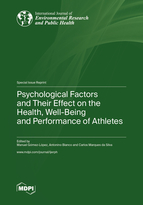Psychological Factors and Their Effect on the Health, Well-Being and Performance of Athletes
A special issue of International Journal of Environmental Research and Public Health (ISSN 1660-4601). This special issue belongs to the section "Sport and Health".
Deadline for manuscript submissions: closed (31 July 2022) | Viewed by 41092
Special Issue Editors
Interests: sport psychology; physical education; motivation; sports; team sports; handball; performance; perfectionism; anxiety and stress; fear of failure; adherence to sport; perceived barriers; resilience
Special Issues, Collections and Topics in MDPI journals
Interests: physical activity; training; strength and conditioning; health promotion; COVID-19 pandemic
Special Issues, Collections and Topics in MDPI journals
Interests: sport psychology; sport performance; mental training
Special Issues, Collections and Topics in MDPI journals
Special Issue Information
Dear Colleagues,
Regular sports practice has a positive influence on the physical, mental, and psychological health of athletes at different levels and in a variety of contexts. Sports performance depends not only on the physical qualities of athletes but also on psychological variables. In a competitive context, knowledge and manipulation of psychological variables such as attention, self-confidence, stress control, anxiety, motivation, cohesion, self-control, or emotional self-regulation, moods, and interpersonal skills can influence the performance and health of an athlete.
Even playing sports can generate feelings of fear of failure and the emergence of feelings of shame, creating a degree of insecurity, anxiety, or stress and avoidance behaviour in athletes, which can affect wellbeing, interpersonal behaviour, and sporting performance.
On the other hand, the outbreak of the COVID-19 pandemic has required the implementation of governamental restrictions, such as quarantine, to contain the spread of the virus. These restrictions may have caused additional fears and stress among athletes, since they were not able to train regularly and properly maintain their physical condition. In addition, competitive sport is a means of socialising, which has an impact on player training, the promotion of a balanced sporting context, and the intention to continue practising the sport. Therefore, the physical and psychological wellbeing of athletes depends mainly on the social environments in which the sport is practised, that is, related to the significant agents in the environment, which social isolation due to the pandemic restrictions may have impaired.
This Special Issue aims to bring together the latest research on these psychological factors that influence sports performance, physical, mental, and psychological health of athletes’ wellbeing and adherence to sport.
Prof. Dr. Manuel Gómez-López
Prof. Dr. Antonino Bianco
Prof. Dr. Carlos Marques da Silva
Guest Editors
Manuscript Submission Information
Manuscripts should be submitted online at www.mdpi.com by registering and logging in to this website. Once you are registered, click here to go to the submission form. Manuscripts can be submitted until the deadline. All submissions that pass pre-check are peer-reviewed. Accepted papers will be published continuously in the journal (as soon as accepted) and will be listed together on the special issue website. Research articles, review articles as well as short communications are invited. For planned papers, a title and short abstract (about 100 words) can be sent to the Editorial Office for announcement on this website.
Submitted manuscripts should not have been published previously, nor be under consideration for publication elsewhere (except conference proceedings papers). All manuscripts are thoroughly refereed through a single-blind peer-review process. A guide for authors and other relevant information for submission of manuscripts is available on the Instructions for Authors page. International Journal of Environmental Research and Public Health is an international peer-reviewed open access monthly journal published by MDPI.
Please visit the Instructions for Authors page before submitting a manuscript. The Article Processing Charge (APC) for publication in this open access journal is 2500 CHF (Swiss Francs). Submitted papers should be well formatted and use good English. Authors may use MDPI's English editing service prior to publication or during author revisions.
Keywords
- psychological well-being
- sports performance
- fear of failure
- stress and anxiety
- burn out
- depression
- fear of COVID-19
- perfectionism
- motivation
- cognitive functions
- social isolation
- self-esteem and body image
- aggressiveness and anger








